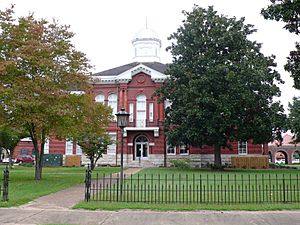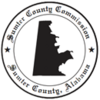Sumter County, Alabama facts for kids
Quick facts for kids
Sumter County
|
||
|---|---|---|

Sumter County Courthouse in Livingston
|
||
|
||

Location within the U.S. state of Alabama
|
||
 Alabama's location within the U.S. |
||
| Country | ||
| State | ||
| Founded | December 18, 1832 | |
| Named for | Thomas Sumter | |
| Seat | Livingston | |
| Largest city | Livingston | |
| Area | ||
| • Total | 913 sq mi (2,360 km2) | |
| • Land | 904 sq mi (2,340 km2) | |
| • Water | 9.4 sq mi (24 km2) 1.0% | |
| Population
(2020)
|
||
| • Total | 12,345 | |
| • Estimate
(2023)
|
11,727 |
|
| • Density | 13.521/sq mi (5.2206/km2) | |
| Time zone | UTC−6 (Central) | |
| • Summer (DST) | UTC−5 (CDT) | |
| Congressional district | 7th | |
|
||
Sumter County is a place in the west-central part of Alabama. It's like a smaller region within the state. In 2020, about 12,345 people lived here. The main town and government center is Livingston. The county is named after General Thomas Sumter from South Carolina. You can also find the University of West Alabama in Livingston.
Contents
History of Sumter County
Sumter County was officially created on December 18, 1832. Before that, from 1797 to 1832, this area was part of the Choctaw Nation. The Choctaw people had four main villages here.
The first European explorers in Sumter County were French. They traveled north from Mobile. These explorers built a settlement called Fort Tombecbee. It was located near where the town of Epes is today.
In 1830, a special agreement called the Treaty of Dancing Rabbit Creek was made. Through this treaty, the Choctaw people gave the land that is now Sumter County to the United States government.
Geography of Sumter County
Sumter County covers a total area of about 913 square miles. Most of this area, about 904 square miles, is land. The rest, about 9.4 square miles, is covered by water. The Noxubee River flows through the county.
Main Roads in Sumter County
Several important roads pass through Sumter County. These roads help people travel and transport goods.
 Interstate 20
Interstate 20 Interstate 59
Interstate 59 U.S. Route 11
U.S. Route 11 U.S. Route 80
U.S. Route 80 State Route 17
State Route 17 State Route 28
State Route 28 State Route 39
State Route 39 State Route 116
State Route 116
Neighboring Counties
Sumter County shares its borders with several other counties.
- Pickens County (to the north)
- Greene County (to the northeast)
- Marengo County (to the southeast)
- Choctaw County (to the south)
- Lauderdale County, Mississippi (to the southwest)
- Kemper County, Mississippi (to the west)
- Noxubee County, Mississippi (to the northwest)
People of Sumter County
| Historical population | |||
|---|---|---|---|
| Census | Pop. | %± | |
| 1840 | 29,937 | — | |
| 1850 | 22,250 | −25.7% | |
| 1860 | 24,035 | 8.0% | |
| 1870 | 24,109 | 0.3% | |
| 1880 | 28,728 | 19.2% | |
| 1890 | 29,574 | 2.9% | |
| 1900 | 32,710 | 10.6% | |
| 1910 | 28,699 | −12.3% | |
| 1920 | 25,569 | −10.9% | |
| 1930 | 26,929 | 5.3% | |
| 1940 | 27,321 | 1.5% | |
| 1950 | 23,610 | −13.6% | |
| 1960 | 20,041 | −15.1% | |
| 1970 | 16,974 | −15.3% | |
| 1980 | 16,908 | −0.4% | |
| 1990 | 16,174 | −4.3% | |
| 2000 | 14,798 | −8.5% | |
| 2010 | 13,763 | −7.0% | |
| 2020 | 12,345 | −10.3% | |
| 2023 (est.) | 11,727 | −14.8% | |
| U.S. Decennial Census 1790–1960 1900–1990 1990–2000 2010–2020 |
|||
Population in 2020
In 2020, the census counted 12,345 people living in Sumter County. There were 5,202 households and 2,764 families.
The population of Sumter County includes people from different backgrounds.
| Race / Ethnicity (NH = Non-Hispanic) | Pop 2000 | Pop 2010 | Pop 2020 | % 2000 | % 2010 | % 2020 |
|---|---|---|---|---|---|---|
| White alone (NH) | 3,813 | 3,304 | 2,937 | 25.77% | 24.01% | 23.79% |
| Black or African American alone (NH) | 10,718 | 10,283 | 8,955 | 72.43% | 74.71% | 72.54% |
| Native American or Alaska Native alone (NH) | 14 | 11 | 26 | 0.09% | 0.08% | 0.21% |
| Asian alone (NH) | 15 | 33 | 102 | 0.10% | 0.24% | 0.83% |
| Pacific Islander alone (NH) | 2 | 1 | 3 | 0.01% | 0.01% | 0.02% |
| Other race alone (NH) | 1 | 0 | 9 | 0.01% | 0.00% | 0.07% |
| Mixed race or Multiracial (NH) | 70 | 45 | 182 | 0.47% | 0.33% | 1.47% |
| Hispanic or Latino (any race) | 165 | 86 | 131 | 1.12% | 0.62% | 1.06% |
| Total | 14,798 | 13,763 | 12,345 | 100.00% | 100.00% | 100.00% |
Population in 2010
In 2010, there were 13,763 people living in the county. About 75% were Black or African American. Around 24.2% were White. Smaller groups included Asian, Native American, and people of two or more races. About 0.6% of the population was Hispanic or Latino.
Economy and Jobs
Sumter County is part of the Black Belt region in central Alabama. This area has faced economic challenges in recent years.
In 2008, a company called United States Steel announced plans for a new factory. This factory would make special metal near Epes. The project was expected to cost $150 million. It would create 250 construction jobs and up to 235 full-time jobs. These jobs would pay about $50,000 per year. The state of Alabama offered $28 million to help bring the factory to Sumter County.
However, in November 2008, U.S. Steel announced that the plans were put on hold. They said construction was delayed, but not canceled. As of today, the Epes factory has not been built.
From 2009 to 2013, the average household income in Sumter County was $22,186. This was lower than the state average of $45,253. By 2015, Sumter County still had the lowest average household income in Alabama.
Education in Sumter County
Sumter County has several options for schooling.
Colleges and Universities
The University of West Alabama is located in Livingston. It offers many different college programs.
Schools for Younger Students
The main school system in the county is the Sumter County School District. There is also a special kind of school called a charter school. The University Charter School is on the campus of the University of West Alabama.
For many years, schools in Sumter County were mostly separated by race. White parents often sent their children to a private school called Sumter Academy. This school was started in 1970 after a court ordered public schools to be open to all races. In the 2015–16 school year, almost all public school students were Black. All students at Sumter Academy were white.
However, Sumter Academy closed in 2017. In 2018, the University Charter School opened. This new school had an equal number of Black and white students. It became the first truly mixed-race school in the county.
Communities in Sumter County
Sumter County has several towns and communities.
Cities
- Livingston (This is the county seat, where the main government offices are.)
- York
Towns
Census-Designated Places
These are areas that are like towns but are not officially incorporated.
Unincorporated Communities
These are smaller communities that are not officially part of a city or town.
- Belmont
- Coatopa
- Intercourse
- Payneville
- Sumterville
- Ward
- Warsaw
Fun Places to Visit
Sumter County offers some interesting places to visit.
- The University of West Alabama in Livingston has an Outdoor Sculpture Exhibition.
- The Coleman Center for the Arts is located in York, Alabama.
- You can also see the historic Alamuchee-Bellamy Covered Bridge on the University of West Alabama campus.
Well-Known People from Sumter County
Some notable individuals have connections to Sumter County.
- Austin Armstrong (born 1993), a football coach who grew up in York, Alabama.
- Jaybird Coleman (1896–1950), a country blues musician known for playing the harmonica.
- Mentor Dotson (c. 1837–?), a Black state legislator who represented Sumter County in the Alabama House of Representatives from 1872 to 1874.
- Maria Fearing (1838–1937), a Black educator and missionary who was born in Sumter County. She later worked in Congo.
- Carol Forman (1919–1997), an actress.
- Amelia Greenwald, an international nurse and the first female driver in Poland.
- Lena King Lee (1906–2006), a Black educator, lawyer, and politician. She was the first Black woman elected to the Maryland General Assembly.
See also
 In Spanish: Condado de Sumter (Alabama) para niños
In Spanish: Condado de Sumter (Alabama) para niños


